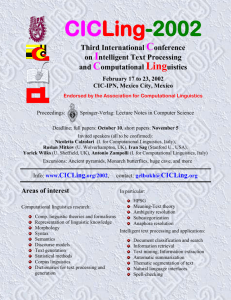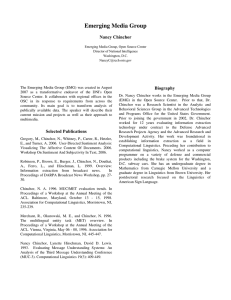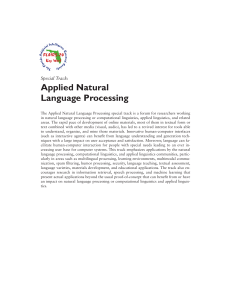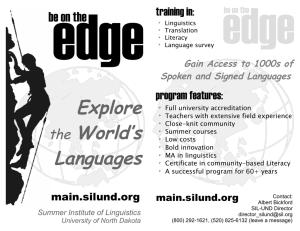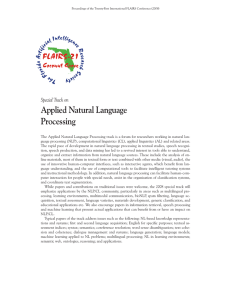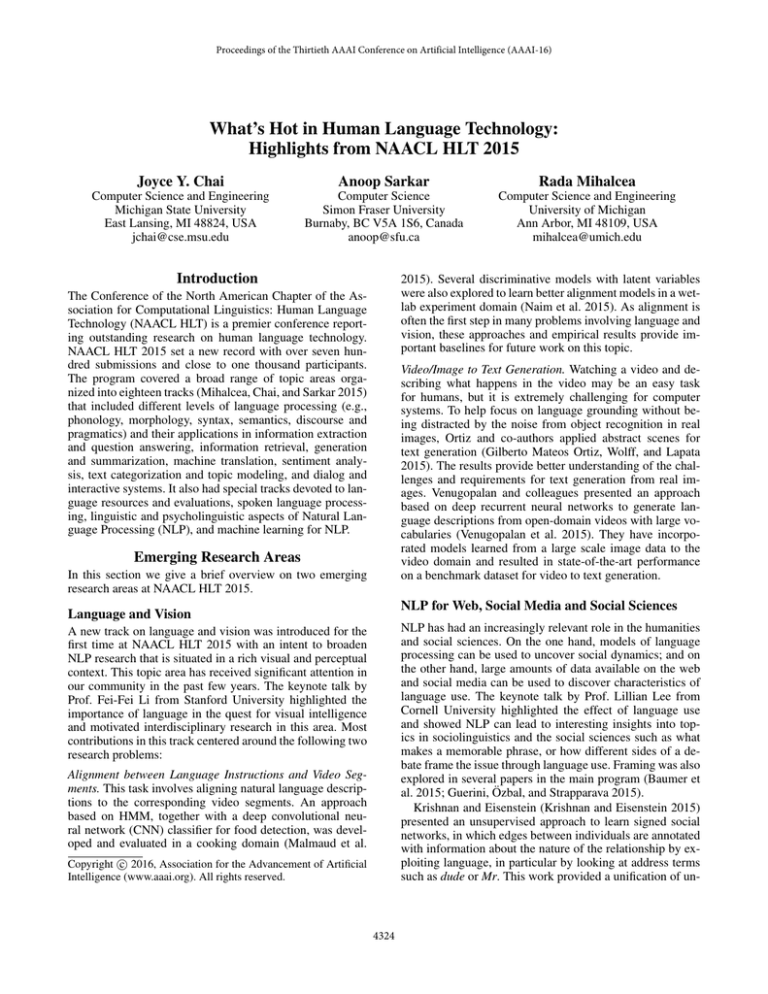
Proceedings of the Thirtieth AAAI Conference on Artificial Intelligence (AAAI-16)
What’s Hot in Human Language Technology:
Highlights from NAACL HLT 2015
Joyce Y. Chai
Anoop Sarkar
Rada Mihalcea
Computer Science and Engineering
Michigan State University
East Lansing, MI 48824, USA
jchai@cse.msu.edu
Computer Science
Simon Fraser University
Burnaby, BC V5A 1S6, Canada
anoop@sfu.ca
Computer Science and Engineering
University of Michigan
Ann Arbor, MI 48109, USA
mihalcea@umich.edu
Introduction
2015). Several discriminative models with latent variables
were also explored to learn better alignment models in a wetlab experiment domain (Naim et al. 2015). As alignment is
often the first step in many problems involving language and
vision, these approaches and empirical results provide important baselines for future work on this topic.
The Conference of the North American Chapter of the Association for Computational Linguistics: Human Language
Technology (NAACL HLT) is a premier conference reporting outstanding research on human language technology.
NAACL HLT 2015 set a new record with over seven hundred submissions and close to one thousand participants.
The program covered a broad range of topic areas organized into eighteen tracks (Mihalcea, Chai, and Sarkar 2015)
that included different levels of language processing (e.g.,
phonology, morphology, syntax, semantics, discourse and
pragmatics) and their applications in information extraction
and question answering, information retrieval, generation
and summarization, machine translation, sentiment analysis, text categorization and topic modeling, and dialog and
interactive systems. It also had special tracks devoted to language resources and evaluations, spoken language processing, linguistic and psycholinguistic aspects of Natural Language Processing (NLP), and machine learning for NLP.
Video/Image to Text Generation. Watching a video and describing what happens in the video may be an easy task
for humans, but it is extremely challenging for computer
systems. To help focus on language grounding without being distracted by the noise from object recognition in real
images, Ortiz and co-authors applied abstract scenes for
text generation (Gilberto Mateos Ortiz, Wolff, and Lapata
2015). The results provide better understanding of the challenges and requirements for text generation from real images. Venugopalan and colleagues presented an approach
based on deep recurrent neural networks to generate language descriptions from open-domain videos with large vocabularies (Venugopalan et al. 2015). They have incorporated models learned from a large scale image data to the
video domain and resulted in state-of-the-art performance
on a benchmark dataset for video to text generation.
Emerging Research Areas
In this section we give a brief overview on two emerging
research areas at NAACL HLT 2015.
NLP for Web, Social Media and Social Sciences
Language and Vision
NLP has had an increasingly relevant role in the humanities
and social sciences. On the one hand, models of language
processing can be used to uncover social dynamics; and on
the other hand, large amounts of data available on the web
and social media can be used to discover characteristics of
language use. The keynote talk by Prof. Lillian Lee from
Cornell University highlighted the effect of language use
and showed NLP can lead to interesting insights into topics in sociolinguistics and the social sciences such as what
makes a memorable phrase, or how different sides of a debate frame the issue through language use. Framing was also
explored in several papers in the main program (Baumer et
al. 2015; Guerini, Özbal, and Strapparava 2015).
Krishnan and Eisenstein (Krishnan and Eisenstein 2015)
presented an unsupervised approach to learn signed social
networks, in which edges between individuals are annotated
with information about the nature of the relationship by exploiting language, in particular by looking at address terms
such as dude or Mr. This work provided a unification of un-
A new track on language and vision was introduced for the
first time at NAACL HLT 2015 with an intent to broaden
NLP research that is situated in a rich visual and perceptual
context. This topic area has received significant attention in
our community in the past few years. The keynote talk by
Prof. Fei-Fei Li from Stanford University highlighted the
importance of language in the quest for visual intelligence
and motivated interdisciplinary research in this area. Most
contributions in this track centered around the following two
research problems:
Alignment between Language Instructions and Video Segments. This task involves aligning natural language descriptions to the corresponding video segments. An approach
based on HMM, together with a deep convolutional neural network (CNN) classifier for food detection, was developed and evaluated in a cooking domain (Malmaud et al.
c 2016, Association for the Advancement of Artificial
Copyright Intelligence (www.aaai.org). All rights reserved.
4324
supervised learning models from NLP with social network
analysis models from the social sciences and received one
of the two best student paper awards at the conference.
Social media provides massive amounts of data, and also
provides opportunities for new NLP tasks, e.g. inferring political orientation from language use (Mohammady Ardehaly and Culotta 2015), or learning response generation
from Twitter conversations (Sordoni et al. 2015).
Deep neural networks have also been very influential in
machine translation (MT). Several papers in this area continued the trend of using NNs and continuous representations
in MT to model larger bilingual contexts (Xing et al. 2015)
and using NNs for preordering the source to minimize issues with diverse word order between source and target in
MT (de Gispert, Iglesias, and Byrne 2015).
NLP Tools
Trends in Methodology
NAACL HLT 2015 has also featured over thirty demos (Gerber, Havasi, and Lacatusu 2015) where researchers demonstrated latest development of integrated systems and NLP
tools. In particular, several tools addressing semantic and
discourse processing have been introduced.
Abstract Meaning Representation (AMR) is a semantic
representation language which intends to assign the same
graph representation to capture the semantics from sentences with the same basic meaning. This representation
has received increasing attention in the NLP community
because of its simplicity and expressive power. Vanderwende and colleagues (Vanderwende, Menezes, and Quirk
2015) have demonstrated a parser that can generate AMR
not only for English sentences, but also for sentences in
French, German, Spanish and Japanese where AMR annotations are not available. A visualization tool is introduced by Saphra and Lopez (Saphra and Lopez 2015) which
will allow developers to better explore AMR annotations
for cross-language alignments. Beyond semantic processing,
Surdeanu and colleagues demonstrated two open-source discourse parsers for Rhetorical Structure Theory (Surdeanu,
Hicks, and Valenzuela-Escarcega 2015) from text.
Distributional Semantic Models
Distributional approaches model semantics of linguistic
items based on the Distributional Hypothesis that words that
are used in the same context tend to have similar meanings.
These approaches have received increasing attention in recent years as they provide a flexible and scalable means to
model inductive learning for word meanings. Several novel
contributions on distributional models have been presented
at the conference, for example, examining semantic composition (Fyshe et al. 2015), addressing verbs with multiple senses (Greenberg, Sayeed, and Demberg 2015), enriching word vectors with visual features (Lazaridou, Pham,
and Baroni 2015), and using substitutes to represent target
words (Melamud, Dagan, and Goldberger 2015).
Faruqui et. al. developed a new method for incorporating
information from semantic resources (e.g., WordNet) into
distributional models (Faruqui et al. 2015). Instead of using
a joint training objective to incorporate taxonomic semantic
knowledge and train distributional word vectors, this work
proposes “retrofitting” that adapts the trained vectors post
hoc. The results have shown the method is more effective
than joint training across a number of common tasks. Since
retrofitting can be applied to any word vectors, this work is
very promising and has received one of the two best student
paper awards at the conference.
Beyond modeling word semantics, Soricut and Och have
applied a distributional approach to learn morphological
transformation rules (Soricut and Och 2015). It accounts
for the semantic relations that exist between words belonging to the same morphological family and utilizes transforms between related word forms in a word embedding
space to induce morphological relations. The evaluations of
this method have shown significant improvements across six
different languages. This work has received the best paper
award at the conference.
Conclusion
NLP has grown into one of the most exciting and diverse
community of researchers, with an ever increasing number of researchers, many big and small companies working
in this field, and a vibrant community of learners eager to
get prepared to take on some of the fun and exciting challenges in the field. NAACL HLT 2015 was a testimony to
the vibrancy and vitality of the field. We have seen several
emerging trends in the field, addressing research at the intersection of language and vision, computational social sciences, and work that take advantage of the recent advances
in distributional semantic models and deep learning. Details
of the activities at the conference venue including papers
grouped by topic are archived on the conference web page:
http://naacl.org/naacl-hlt-2015.
We are only able to give a few examples here. Many interesting and novel contributions were featured at the conference. We encourage the reader to visit the ACL Anthology (http://www.aclweb.org/anthology/N15-1) which contains
an open-access repository of the NAACL HLT 2015 program. The ACL Anthology (http://aclweb.org/anthology/) contains all of the journals, conferences and workshops in NLP
since 1965.
Deep Neural Networks
We have also observed an increasing interest in applying
deep neural networks (NNs) to many diverse NLP tasks
such as document categorization (Johnson and Zhang 2015),
video-to-text generation (Venugopalan et al. 2015), word
sense disambiguation (Taghipour and Ng 2015), paraphrase
identification (Yin and Schütze 2015; Zhao, Hassan, and
Auli 2015),and learning response generation from Twitter
conversations (Sordoni et al. 2015), etc. Effective discriminative training of NNs was also a focus, with multi-task
learning as one of the approaches (Liu et al. 2015).
4325
References
of NAACL HLT 2015, 472–482. Denver, Colorado: Association
for Computational Linguistics.
Mihalcea, R.; Chai, J.; and Sarkar, A., eds. 2015. Proceedings of
NAACL HLT 2015. Denver, Colorado: Association for Computational Linguistics.
Mohammady Ardehaly, E., and Culotta, A. 2015. Inferring latent
attributes of twitter users with label regularization. In Proceedings of NAACL HLT 2015, 185–195. Denver, Colorado: Association for Computational Linguistics.
Naim, I.; Song, Y. C.; Liu, Q.; Huang, L.; Kautz, H.; Luo, J.; and
Gildea, D. 2015. Discriminative unsupervised alignment of natural language instructions with corresponding video segments. In
Proceedings of NAACL HLT 2015, 164–174. Denver, Colorado:
Association for Computational Linguistics.
Saphra, N., and Lopez, A. 2015. Amrica: an amr inspector for
cross-language alignments. In Proceedings of the 2015 Conference of the North American Chapter of the Association for Computational Linguistics: Demonstrations, 36–40. Denver, Colorado: Association for Computational Linguistics.
Sordoni, A.; Galley, M.; Auli, M.; Brockett, C.; Ji, Y.; Mitchell,
M.; Nie, J.-Y.; Gao, J.; and Dolan, B. 2015. A neural network approach to context-sensitive generation of conversational
responses. In Proceedings of NAACL HLT 2015, 196–205. Denver, Colorado: Association for Computational Linguistics.
Soricut, R., and Och, F. 2015. Unsupervised morphology induction using word embeddings. In Proceedings of NAACL HLT
2015, 1627–1637. Denver, Colorado: Association for Computational Linguistics.
Surdeanu, M.; Hicks, T.; and Valenzuela-Escarcega, M. A. 2015.
Two practical rhetorical structure theory parsers. In Proceedings
of the 2015 Conference of the North American Chapter of the
Association for Computational Linguistics: Demonstrations, 1–
5. Denver, Colorado: Association for Computational Linguistics.
Taghipour, K., and Ng, H. T. 2015. Semi-supervised word sense
disambiguation using word embeddings in general and specific
domains. In Proceedings of NAACL HLT 2015, 314–323. Denver, Colorado: Association for Computational Linguistics.
Vanderwende, L.; Menezes, A.; and Quirk, C. 2015. An amr
parser for english, french, german, spanish and japanese and a
new amr-annotated corpus. In Proceedings of the 2015 Conference of the North American Chapter of the Association for Computational Linguistics: Demonstrations, 26–30. Denver, Colorado: Association for Computational Linguistics.
Venugopalan, S.; Xu, H.; Donahue, J.; Rohrbach, M.; Mooney,
R.; and Saenko, K. 2015. Translating videos to natural language
using deep recurrent neural networks. In Proceedings of NAACL
HLT 2015, 1494–1504. Denver, Colorado: Association for Computational Linguistics.
Xing, C.; Wang, D.; Liu, C.; and Lin, Y. 2015. Normalized word
embedding and orthogonal transform for bilingual word translation. In Proceedings of NAACL HLT 2015, 1006–1011. Denver,
Colorado: Association for Computational Linguistics.
Yin, W., and Schütze, H. 2015. Convolutional neural network for
paraphrase identification. In Proceedings of NAACL HLT 2015,
901–911. Denver, Colorado: Association for Computational Linguistics.
Zhao, K.; Hassan, H.; and Auli, M. 2015. Learning translation
models from monolingual continuous representations. In Proceedings of NAACL HLT 2015, 1527–1536. Denver, Colorado:
Association for Computational Linguistics.
Baumer, E.; Elovic, E.; Qin, Y.; Polletta, F.; and Gay, G. 2015.
Testing and comparing computational approaches for identifying
the language of framing in political news. In Proceedings of
NAACL HLT 2015, 1472–1482. Denver, Colorado: Association
for Computational Linguistics.
de Gispert, A.; Iglesias, G.; and Byrne, B. 2015. Fast and accurate preordering for smt using neural networks. In Proceedings of
NAACL HLT 2015, 1012–1017. Denver, Colorado: Association
for Computational Linguistics.
Faruqui, M.; Dodge, J.; Jauhar, S. K.; Dyer, C.; Hovy, E.; and
Smith, N. A. 2015. Retrofitting word vectors to semantic lexicons. In Proceedings of NAACL HLT 2015, 1606–1615. Denver,
Colorado: Association for Computational Linguistics.
Fyshe, A.; Wehbe, L.; Talukdar, P. P.; Murphy, B.; and Mitchell,
T. M. 2015. A compositional and interpretable semantic space.
In Proceedings of NAACL HLT 2015, 32–41. Denver, Colorado:
Association for Computational Linguistics.
Gerber, M.; Havasi, C.; and Lacatusu, F., eds. 2015. Proceedings of the 2015 Conference of the North American Chapter of
the Association for Computational Linguistics: Demonstrations.
Denver, Colorado: Association for Computational Linguistics.
Gilberto Mateos Ortiz, L.; Wolff, C.; and Lapata, M. 2015.
Learning to interpret and describe abstract scenes. In Proceedings of NAACL HLT 2015, 1505–1515. Denver, Colorado: Association for Computational Linguistics.
Greenberg, C.; Sayeed, A.; and Demberg, V. 2015. Improving
unsupervised vector-space thematic fit evaluation via role-filler
prototype clustering. In Proceedings of NAACL HLT 2015, 21–
31. Denver, Colorado: Association for Computational Linguistics.
Guerini, M.; Özbal, G.; and Strapparava, C. 2015. Echoes of
persuasion: The effect of euphony in persuasive communication.
In Proceedings of NAACL HLT 2015, 1483–1493. Denver, Colorado: Association for Computational Linguistics.
Johnson, R., and Zhang, T. 2015. Effective use of word order
for text categorization with convolutional neural networks. In
Proceedings of NAACL HLT 2015, 103–112. Denver, Colorado:
Association for Computational Linguistics.
Krishnan, V., and Eisenstein, J. 2015. youre mr. lebowski, im the
dude: Inducing address term formality in signed social networks.
In Proceedings of NAACL HLT 2015, 1616–1626. Denver, Colorado: Association for Computational Linguistics.
Lazaridou, A.; Pham, N. T.; and Baroni, M. 2015. Combining language and vision with a multimodal skip-gram model. In
Proceedings of NAACL HLT 2015, 153–163. Denver, Colorado:
Association for Computational Linguistics.
Liu, X.; Gao, J.; He, X.; Deng, L.; Duh, K.; and Wang, Y.-Y.
2015. Representation learning using multi-task deep neural networks for semantic classification and information retrieval. In
Proceedings of NAACL HLT 2015, 912–921. Denver, Colorado:
Association for Computational Linguistics.
Malmaud, J.; Huang, J.; Rathod, V.; Johnston, N.; Rabinovich,
A.; and Murphy, K. 2015. “what’s cooking?” interpreting cooking videos using text, speech and vision. In Proceedings of
NAACL HLT 2015, 143–152. Denver, Colorado: Association for
Computational Linguistics.
Melamud, O.; Dagan, I.; and Goldberger, J. 2015. Modeling
word meaning in context with substitute vectors. In Proceedings
4326


